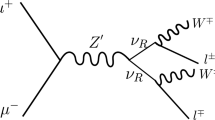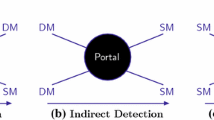Abstract
In the present article, we employ the Regge phenomenology to describe the mass-spectra of singly charmed baryons. With the assumption of linear Regge trajectories, the relations between Regge slopes, intercepts, and baryon masses are derived. Using these relations we evaluated the Regge slopes (\(\alpha ^{'}\)) for \(\varLambda _{c}^{+}\), \(\varSigma _{c}^{++,+,0}\), \(\varXi _{c}^{+,0}\), \(\varXi _{c}^{'+,0}\), and \(\varOmega _{c}^{0}\) baryons and obtain the orbitally excited state masses in the \((J,M^{2})\) plane. Similarly, the Regge parameters (\(\beta \) and \(\beta _{0}\)) are estimated for each Regge line in the \((n,M^{2})\) plane and the radially excited state masses are obtained. Also, the experimental errors are calculated in the obtained results wherever the experimental inputs are taken. Further the Regge trajectories are plotted for our calculated masses in the (\(J,M^{2}\)) plane. We compared our estimated results with the experimental data and other theoretical predictions. We assign the spin–parity of recently observed experimental states \(\varSigma _{c}(2800)\), \(\varXi _{c}(2923)\), \(\varXi _{c}(3123)\), \(\varOmega _{c}(3000)\), \(\varOmega _{c}(3050)\), \(\varOmega _{c}(3065)\), \(\varOmega _{c}(3090)\) and \(\varOmega _{c}(3119)\) in this work.









Similar content being viewed by others
Data Availability
This manuscript has no associated data or the data will not be deposited. [Authors’ comment: Other than the data in the tables provided in the article, there is no other data available.]
References
T. Aaltonen et al., (CDF Collaboration), Phys. Rev. D 84, 012003 (2011)
M. Artuso et al., (CLEO Collaboration), Phys. Rev. Lett. 86, 4479 (2001)
B. Aubert et al., (BABAR Collaboration), Phys. Rev. Lett. 98, 012001 (2007)
K. Abe et al., (Belle Collaboration), Phys. Rev. Lett. 98, 262001 (2007)
R. Aaij et al., (LHCb Collaboration), JHEP 05, 030 (2017)
R. Mizuk et al., (Belle Collaboration), Phys. Rev. Lett. 94, 122002 (2005)
B. Aubert et al., (BABAR Collaboration), Phys. Rev. D 78, 112003 (2008)
R.L. Workman et al. (Particle Data Group), Prog. Theor. Exp. Phys. 2022, 083C01 (2022)
B. Aubert et al., (BABAR Collaboration), Phys. Rev. D 77, 012002 (2008)
Y. Kato et al., (Belle Collaboration), Phys. Rev. D 89, 052003 (2014)
Y.B. Li et al., (Belle Collaboration), Eur. Phys. J. C 78, 928 (2018)
Y.B. Li et al., (Belle Collaboration), Eur. Phys. J. C 78, 252 (2018)
R. Aaij et al., (LHCb Collaboration), Phys. Rev. Lett. 124, 222001 (2020)
T.J. Moon et al., (Belle Collaboration), Phys. Rev. D 103, L111101 (2021)
R. Aaij et al., (LHCb Collaboration), Phys. Rev. Lett. 118, 182001 (2017)
LHCb Collaboration, Sci. Bull. 67, 479-487 (2022)
J. Oudichhya, K. Gandhi, A.K. Rai, Phys. Rev. D 103, 114030 (2021)
H.G. -Tecocoatzi, A. Giachino, J. Li, A.R. Morales, E. -Santopinto, Phys. Rev. D 107, 034031 (2023)
E. Ortiz-Pacheco et al., J. Phys. Conf. Ser. 1610, 012011 (2020)
Y. Kim, Y.-R. Liu, M. Oka, K. Suzuki, Phys. Rev. D 104, 054012 (2021)
M.V. Polyakov, M. Praszałowicz, Phys. Rev. D 105, 094004 (2022)
D. Jia, W.-N. Liu, A. Hosaka, Phys. Rev. D 101, 034016 (2020)
H.-Y. Cheng, C.-W. Chiang, Phys. Rev. D 95, 094018 (2017)
G.-L. Yu, Z.-Yu Li, Z.-G. Wang, L. Jie, Y. Meng, (2022) arXiv:2206.08128v3 [hep-ph]
Y.-X. Song, D. Jia, W.-X. Zhang, A. Hosaka, Eur. Phys. J. C 83, 1 (2023)
H-Yang. Cheng, Chin. J. Phys. 78, 324–362 (2022)
Z. Shah, K. Thakkar, A.K. Rai, P.C. Vinodkumar, Chin. Phys. C 40, 123102 (2016)
F. Gross et al., arXiv:2212.11107 [hep-ph]
D. Ebert, R.N. Faustov, V.O. Galkin, Phys. Rev. D 84, 014025 (2011)
D. Ebert, R.N. Faustov, V.O. Galkin, Phys. Lett. B 659, 612 (2008)
B. Chen, K.W. Wei, X. Liu, T. Matsuki, Eur. Phys. J. C 77, 154 (2017)
H. Bahtiyar et al., (TRJQCD Collaboration), Phys. Rev. D 102, 054513 (2020)
H.-Xi. Chen et al., Rep. Prog. Phys. 86, 026201 (2023)
H. B. Li et al., (BESIII collaboration), (2022) arXiv:2204.08943v1 [hep-ex]
K. Gandhi, A.K. Rai, Eur. Phys. J. Plus 135, 213 (2020)
K. Gandhi, Z. Shah, A.K. Rai, Int. J. Theor. Phys. 59, 1129–1156 (2020)
H.-M. Yang, H.-X. Chen, Phys. Rev. D 104, 034037 (2021)
R. Bijker, H. García-Tecocoatzi, A. Giachino, E. Ortiz-Pacheco, E. Santopinto, Phys. Rev. D 105, 074029 (2022)
E. Santopinto, A. Giachino et al., Eur. Phys. J. C 79, 1012 (2019)
J. Oudichhya, K. Gandhi, A.K. Rai, Phys. Rev. D 104, 114027 (2021)
J. Oudichhya, K. Gandhi, A.K. Rai, Phys. Scr. 97, 054001 (2022)
J. Oudichhya, K. Gandhi, A.K. Rai, arXiv:2304.05110v1 [hep-ph]
J. Oudichhya, K. Gandhi, A. K. Rai, Nucl. Phys. A 1035, 122658 (2023)
Z. Shah, K. Thakkar, A.K. Rai, P.C. Vinodkumar, Eur. Phys. J. A 52, 313 (2016)
B. Chen, K.W. Wei, A. Zhang, Eur. Phys. J. A 51, 82 (2015)
Y. Nambu, Phys. Rev. D 10, 4262 (1974)
Y. Nambu, Phys. Lett. B 80, 372 (1979)
X.H. Guo, K.-W. Wei, X.H. Wu, Phys. Rev. D 78, 056005 (2008)
A.B. Kaidalov, Z. Phys. C 12, 63 (1982)
L. Burakovsky, T. Goldman, L.P. Horwitz, Phys. Rev. D 56, 7119 (1997)
L. Burakovsky, T. Goldman, Phys. Lett. B 434, 251 (1998)
K. Kawarabayashi, S. Kitakado, H. Yabuki, Phys. Lett. 28B, 432 (1969)
V.V. Dixit, L.A.P. Balazs, Phys. Rev. D 20, 816 (1979)
L. Burakovsky, T. Goldman, L.P. Horwitz, Phys. Rev. D 56, 7124 (1997)
T. Yoshida, E. Hiyama, A. Hosaka, M. Oka, K. Sadato, Phys. Rev. D 92, 114029 (2015)
Y. Yamaguchi et al., Phys. Rev. D 91, 034034 (2015)
W. Roberts, M. Pervin, Int. J. Mod. Phys. A 23, 2817 (2008)
H. Garcilazo, J. Vijande, A. Valcarce, J. Phys. G 34, 961 (2007)
A. Valcarce, H. Garcilazo, J. Vijande, Eur. Phys. J. A 37, 217 (2008)
M. Karliner, J.L. Rosner, Phys. Rev. D 95, 114012 (2017)
D. Jia, J.-H. Pai, C.-Q. Pang, Eur. Phys. J. C. 18, 434 (2021)
G. Barucca et al., (PANDA Collaboration), Eur. Phys. J. A 57, 184 (2021)
Author information
Authors and Affiliations
Corresponding author
Additional information
Communicated by Evgeni Kolomeitsev.
Appendix
Appendix
The experimental errors are incorporated in the present work. In this section we give the detailed description and calculation of the error analysis. We have calculated the experimental errors wherever the experimental values are taken as input. Since to calculate the error in slope \(\alpha _{jjq}\), we have obtained from Eq. (17), firstly we have to obtain the error in \(\alpha _{iiq}\). Since we have,
Equation (28) can be written as,
where,
Hence, error in k can be given as,
Here \(M_{J+2}\) and \(M_{J}\) are the experimental masses taken as input including their error values \(\delta M_{J+2}\) and \(\delta M_{J}\) respectively. Now error in slope \(\alpha _{iiq}\) from Eq. (29) can be given as,
Hence with the aid of Eqs. (30), (31), and (32) we can obtain the value of \( \delta \alpha _{iiq}\). Now from Eq. (17):
The above equation can also be written as,
where,
and
Error in Eq. (34) is given as,
From Eq. (36) error in y can be given as,
Now to calculate the error in x, we can write Eq. (35) can be written as
Hence,
where,
Let, \(P = a+b\) where,
and
Now error in P can be given as,
From Eq. (42) we can have,
Here \(M_{ijq}\), \(M_{jjq}\), and \(M_{iiq}\) are the experimental masses which are taken as input and \(\delta M_{ijq}\), \(\delta M_{jjq}\), and \(\delta M_{iiq}\) respectively, represents their error values. Now to calculate error in b, Eq. (43) is written as,
Since, error in b is given as,
where,
We can write Eq. (48) as,
where,
and,
Hence,
Now, form Eqs. (45) and (50) we can write the error in H as,
Putting the value of \(\delta a\) and H from Eqs. (45) and (50) into Eq. (53), we can obtain the value of \(\delta H\). Now, from Eq. (51) we can have,
Inserting the values of \(\delta H\) and \(\delta G\) into Eq. (52), we get the value of \(\delta F\). Using the value of \(\delta F\) and form Eq. (48) we can find \(\delta b\). Hence, from Eqs. (32), (40), (41), and (44) we can calculate the value of \(\delta x\). Now putting the values of \(\delta x\) and \(\delta y\) from Eqs. (40) and (38) respectively, in Eq. (37) we can finally get the error in slope value i.e. \(\delta \alpha ^{'}_{jjq}\) which are shown in Table 1.
In the similar manner, we can evaluate the error in slope (\(\alpha _{ijq}\)) obtained from Eq. (18). Once we get error in slope values, now we have obtained the error values in excited state masses, obtained from Eq. (24). Now Eq. (24) can also be written as,
where,
Error in Q from Eq. (56) can be given as,
where \(\alpha ^{'}\) and \(\delta \alpha ^{'}\) represents the value of slopes we have determined in the present work for singly charmed baryons and their error values we have obtained from above calculation. Also error in excited state masses \(M_{J+1}\) is represented by \(\delta M_{J+1}\). Hence from Eq. (55) we can have,
Hence from Eqs. (56), (57), and (58) can obtained the error values in excited state masses in the (\(J,M^{2}\)) plane which are shown in Tables 2, 3, 4, 5 and 6.
Similarly, we can determine the error values for Regge slopes and intercept calculated in the (\(n,M^{2}\)) plane which are shown in Table 7 and also error in the radially excited state masses evaluated in the (\(n,M^{2}\)) plane for singly charmed baryons.
Rights and permissions
Springer Nature or its licensor (e.g. a society or other partner) holds exclusive rights to this article under a publishing agreement with the author(s) or other rightsholder(s); author self-archiving of the accepted manuscript version of this article is solely governed by the terms of such publishing agreement and applicable law.
About this article
Cite this article
Oudichhya, J., Rai, A.K. Spin–parity identification of newly observed singly charmed baryons in Regge phenomenology. Eur. Phys. J. A 59, 123 (2023). https://doi.org/10.1140/epja/s10050-023-01024-5
Received:
Accepted:
Published:
DOI: https://doi.org/10.1140/epja/s10050-023-01024-5




